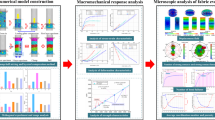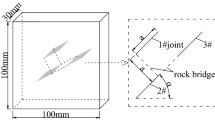Abstract
The anisotropy of rockfill materials has a significant influence on the performance of engineering structures. However, relevant research data are very limited, because of the difficulty with preparing specimens with different inclination angles using traditional methods. Furthermore, the anisotropy test of rockfill materials is complex and complicated, especially for triaxial tests, in which the major principal stress plane intersects with the compaction plane at different angles. In this study, the geometric characteristics of a typical particle fraction consisting of a specific rockfill material were statistically investigated, and the distribution characteristics of particle orientation in specimens prepared via different compaction methods were examined. For high-density rockfill materials, a set of specimen preparation devices for inclined compaction planes was developed, and a series of conventional triaxial compression tests with different principal stress direction angles were conducted. The results reveal that the principal stress direction angle has a significant effect on the modulus, shear strength, and dilatancy of the compacted rockfill materials. Analysis of the relationship between the principal stress direction angles, change in the stress state, and change in the corresponding dominant shear plane shows that the angle between the compacted surface and dominant shear plane is closely related to interlocking resistance associated with the particle orientation. In addition, different principal stress direction angles can change the extent of the particle interlocking effect, causing the specimen to exhibit different degrees of anisotropy.
Similar content being viewed by others
References
Yin Z Z, Zhang K Y, Zhu J G. Anisotropy of soil considered in stress and deformation calculation of plane rockfill dam. Chinese Journal of Hydraulic Engineering, 2004, 35(11): 22–26 (in Chinese)
Gurevich B, Pervukhina M, Makarynska D. An analytic model for the stress-induced anisotropy of dry rocks. Geophysics, 2011, 76(3): WA125–WA133
Yang J, Li G Y, Shen T. Stress-deformation properties of super-high CFRDs under complex terrain conditions. Chinese Journal of Geotechnical Engineering, 2014, 23(4): 407–411 (in Chinese)
Jia Y A. Comparison and verification of constitutive models for rockfill materials under complex stress path. Dissertation for the Doctoral Degree. Beijing: Tsinghua University, 2006 (in Chinese)
Li X S, Dafalias Y F. Constitutive modeling of inherently anisotropic sand behavior. Journal of Geotechnical and Geoenvironmental Engineering, 2002, 128(10): 868–880
Shi W C. True triaxial test on coarse-grained soil and study on constitutive model. Dissertation for the Doctoral Degree. Nanjing: Hohai University, 2008 (in Chinese)
Wang Y, Yu Y Z, Wu Y K, Zhang B Y, Lv H, Sun X. Development and application of a large-scale static and dynamic true triaxial apparatus for gravel. International Journal of Geomechanics, 2018, 18(3): 04018004
Veiskarami M, Ghorbani A, Alavipour M. Development of a constitutive model for rockfills and similar granular materials based on the disturbed state concept. Frontiers of Structural and Civil Engineering, 2012, 6(4): 365–378
Zhang F, Ye B, Ye G L. Unified description of sand behavior. Frontiers of Architecture and Civil Engineering in China, 2011, 5(2): 121–150
Zhang D M, Yin Z Y, Hicher P Y, Huang H W. Analysis of cement-treated clay behavior by micromechanical approach. Frontiers of Structural and Civil Engineering, 2013, 7(2): 137–153
Huang M S, Yao Y P, Yin Z Y, Liu E L, Lei H Y. An overview on elementary mechanical behaviors, constitutive modeling and failure criterion of soils. China Civil Engineering Journal, 2016, 49(7): 9–35 (in Chinese)
Duncan J M, Seed H B. Anisotropy and stress reorientation in clay. Journal of the Soil Mechanics and Foundations Division, 1966, 92(5): 21–50
Tong Z X, Zhou S P, Yao Y P, Shi G. An improved direct shear apparatus for shear strength of anisotropic sands and its primary application. Chinese Journal of Rock Mechanics and Engineering, 2012, 31(12): 2579–2580 (in Chinese)
Guo P J. Modified direct shear test for anisotropic strength of sand. Journal of Geotechnical and Geoenvironmental Engineering, 2008, 134(9): 1311–1318
Oda M, Koishikawa I, Higuchi T. Experimental study of anisotropic shear strength of sand by plane strain test. Soil and Foundation, 1978, 18(1): 25–38
Yamada Y, Ishihara K. Anisotropic deformation characteristics of sand under three dimensional stress conditions. Soil and Foundation, 1979, 19(2): 79–94
Abelev A V, Lade P V. Effects of cross anisotropy on three-dimensional behavior of sand. I: Stress-strain behavior and shear banding. Journal of Engineering Mechanics, 2003, 129(2): 160–166
Lade P V, Abelev A V. Effects of cross anisotropy on three-dimensional behavior of sand. II: Volume change behavior and failure. Journal of Engineering Mechanics, 2003, 129(2): 167–174
Shao S J, Xu P, Wang Q, Dai Y F. True triaxial tests on anisotropic strength characteristics of loess. Chinese Journal of Geotechnical Engineering, 2014, 36(9): 1614–1623 (in Chinese)
Guo Y, Mo Y B. Research on inherent anisotropy of saturated sand specimen. Journal of Disaster Prevention and Mitigation Engineering, 2018, 38(02): 251–257 (in Chinese)
Wei K M, Zhu S. A generalized plasticity model to predict behaviors of the concrete-faced rock-fill dam under complex loading conditions. European Journal of Environmental and Civil Engineering, 2013, 17(7): 579–597
Symes M J, Gens A, Hight D W. Undrained anisotropy and principal stress rotation in saturated sand. Geotechnique, 1984, 34(1): 11–27
Sun Y F, Shen Y. Constitutive model of granular soils using fractional-order plastic-flow rule. International Journal of Geomechanics, 2017, 17(8): 04017025
Tong Z X. Research on deformation behavior and constitutive model of sands under cyclic rotation of principal stress axes. Dissertation for the Doctoral Degree. Beijing: Tsinghua University, 2008 (in Chinese)
Yu Y L. Research on constitutive law and mathematical model of anisotropic sands under rotation of principal stress axes. Dissertation for the Doctoral Degree. Beijing: Tsinghua University, 2010 (in Chinese)
Rodriguez N M. Experimental study of 3D failure plane for crossanisotropic sand deposits during stress rotation. Dissertation for the Doctoral Degree. Washington, D.C.: Catholic University of America, 2012
Yang Z X, Yang J, Wang L Z. Micro-scale modeling of anisotropy effects on undrained behavior of granular soils. Granular Matter, 2013, 15(5): 557–572
Yang L T. Experimental study of soil anisotropy using hollow cylinder testing. Dissertation for the Doctoral Degree. Nottingham: University of Nottingham, 2013
Yang Z X, Li X S, Ming H Y. Fabric anisotropy and undrained shear behavior of granular soil. Shenzhen Daxue Xuebao (Ligong Ban). Journal of Shenzhen University Science and Engineering, 2009, 26(2): 158–163 (in Chinese)
Chaudhary S K, Kuwano J, Hashimoto S, Hayano Y, Nakamura Y. Effects of initial fabric and shearing direction on cyclic deformation characteristics of sand. Soil and Foundation, 2002, 42(1): 147–157
Yang Z X, Li X S, Yang J. Quantifying and modelling fabric anisotropy of granular soils. Geotechnique, 2008, 58(4): 237–248
Suwal L P, Kuwano R. Statically and dynamically measured poisson’s ratio of granular soils on triaxial laboratory specimens. Geotechnical Testing Journal, 2013, 36(4): 493–505
Zhao C B, Hobbs B E, Ord A. Fundamentals of Computational Geoscience: Numerical Methods and Algorithms. Berlin: Springer, 2009
Zhao C B. Physical and Chemical Dissolution Front Instability in Porous Media: Theoretical Analyses and Computational Simulations. Berlin: Springer, 2014
Xu M, Hong J T, Song E X. DEM study on the effect of particle breakage on the macro-and micro-behavior of rockfill sheared along different stress paths. Computers and Geotechnics, 2017, 89: 113–127
Luo T, Li G, Ooie T, Chan A H C, Fu S J, Zou W L. DEM modelling of macro- and meso-mechanisms for rockfill materials. Engineering Journal of Wuhan University, 2018, 51(07): 607–612 (in Chinese)
Zhang D. Numerical analysis and constitutive simulation of anisotropic granular materials considering fabric evolution. Dissertation for the Doctoral Degree. Beijing: University of Science and Technology Beijing, 2017 (in Chinese)
Chu F Y, Zhu J G, Zhao Y H, He S B. An elastoplastic model for granular soil considering initial anisotropy. Journal of Central South University (Natural Science Edition), 2012, 5(43): 1914–1919
Zhang K Y, Wen D B, Ma Q H. Three-dimensional anisotropic revision and experimental verification of elliptic parabolic double yield surface elastoplastic model. Journal of Rock Mechanics and Engineering, 2013, 32(8): 1692–1700
Oda M, Nakayama H. Introduction of inherent anisotropy of soils in the yield function. Studies in Applied Mechanics, 1988, 20: 81–90
Oda M, Nemat-Nasser S, Konishi J. Stress-induced anisotropy in granular masses. Soil and Foundation, 1985, 25(3): 85–97
Wang Y. The Mechanical characteristics of rockfill materials under true triaxial stress conditions. Dissertation for the Doctoral Degree. Beijing: Tsinghua University, 2018 (in Chinese)
Dong T, Kong L, Zheng Y R, Yuan Q M, Liu W Z. Equivalent nonlinear model considering the anisotropy and the stress directionality of geomaterials. Journal of Rock Mechanics and Engineering, 2018, 37(2): 506–512 (in Chinese)
Dong T, Zheng Y R, Kong L, Zhe M. Strength criteria and slipping planes of anisotropic sand considering direction of major principal stress. Chinese Journal of Geotechnical Engineering, 2018, 40(4): 736–742 (in Chinese)
Arthur J, Menzies B K. Inherent anisotropy in a sand. Geotechnique, 1972, 22(1): 115–128
Acknowledgements
This work was supported by the National Key R&D Program of China (No. 2017YFC0404802) and the National Natural Science Foundation of China (Grant Nos. U1965206 and 51979143).
Author information
Authors and Affiliations
Corresponding author
Rights and permissions
About this article
Cite this article
Zhang, X., Gao, Y., Wang, Y. et al. Experimental study on compaction-induced anisotropic mechanical property of rockfill material. Front. Struct. Civ. Eng. 15, 109–123 (2021). https://doi.org/10.1007/s11709-021-0693-0
Received:
Accepted:
Published:
Issue Date:
DOI: https://doi.org/10.1007/s11709-021-0693-0




